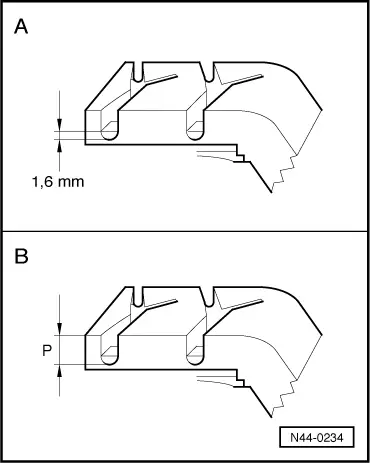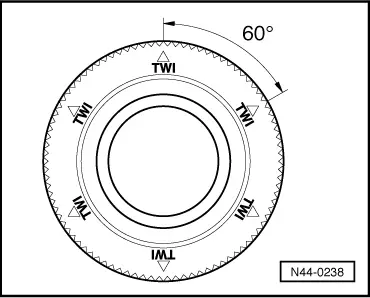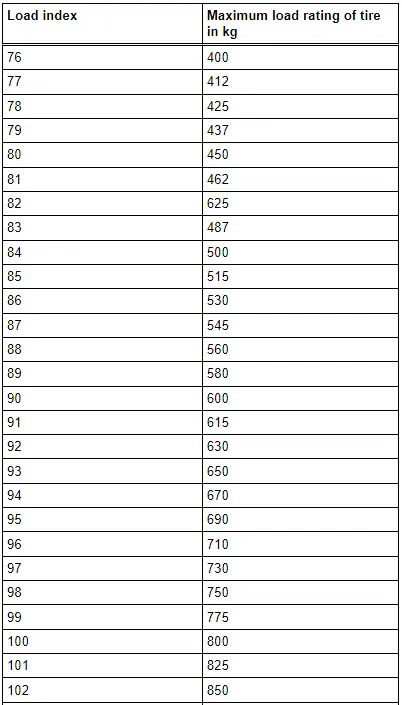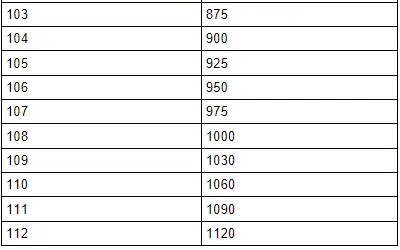Audi Q7: Tread Depth, Measuring
 Note
Note
- When measuring tread depth, take measurements in the main grooves.
- Do not measure on the TWI (tread wear indicator).
Tread depth of a tire must be measured in the main grooves at the points showing the most wear. Main tread grooves can be recognized by the TWI. The positions of the tread wear indicators are visible several times along the tire shoulder. The TWI protrusions are 1.6 mm tall. This is the minimum tread depth legally prescribed in Germany.
Different values may apply in other countries.
Tread Wear Indicators (TWI) must not be included in the measurement. The deepest point of the groove must be used for the measurement.

A - Tread wear indicators (TWIs) in main tread grooves. Items can be identified six times on the circumference of the tire shoulder.
B - Tread depth -P- in the main tread groove.
Tread wear indicators - TWI
TWI → Note is visible six times on the circumference of the tire shoulder.
1) Tread Wear Indicator means profile wear display

Speed Code/High Speed

Winter Tires with Speed Rating "V". Refer to → Chapter "Winter Tires with Speed Rating V".
Tires, Speed Ratings
The speed rating (for example "T") behind the tire size specification (for example 185/65 R 14 86T) indicates the maximum permissible speed (vmax) for the tire.
When selecting the tires for a vehicle, ensure that their maximal permissible speed lies above the maximum speed attainable by the vehicle ("design-related").
Formula for Vehicles with Speed Rating "v" from 151 km/h (94 mph)
vmax = 1.01 x v + 6.5 km/h (4.04 mph)
Example: Indicated maximum speed v = 163 km/h (101.28 mph)
vmax = 1.01 x 163 km/h + 6.5 km/h = 171.13 km/h (1.01 x 101.28 mph + 4.04 mph = 106.34 mph)
In this example, a "S"-tire or a tire with a higher-order speed rating must be used.
 Note
Note
For the letter "v", enter the specified maximum speed in the vehicle registration Part I or II in the field "T" or in the vehicle title under number 6. This conversion is necessary, because due to technical reasons, all vehicles reach different maxim speeds within a legally permissible range.
Winter Tires with Speed Rating "V"
The tire industry delivers winter tires with V-rating also. These tires can be applied up to the maximum permissible speed vmax = 240 km/h (150 mph) only under certain conditions.
Vehicles with V-tires:
Vehicles that require V-tires according to vehicle registration, can be driven with V winter tires without limitations up to speed rating "v"max = 240 km/h (150 mph).
Vehicles with W-, Y- or ZR-tires:
Vehicles that require W, Y, or ZR tires according to vehicle registration, cannot be driven with V winter tires up to "v"max = 240 km/h (150 mph) under certain conditions.
Why?
V summer tires and V winter tires without special designation guarantee 100% of the load capacity indicated by their Load Index ("LI") only up to a speed of 210 km/h (131 mph).
Speeds above 210 km/h (131 mph) are only possible if the maximum load capacity of the tire is not exceeded. The load capacity of the tire decreases as the speed increases.
The maximum permissible axle load and the attainable maximum speed of certain Audi vehicles are so high that the load capacity of V tires is not sufficient for speeds above 240 km/h (150 mph).
Example: Tire 205/55 R 16 91V
The Load index (LI) 91 for this tire indicates a load capacity of 615 kg (1356 lb) per tire up to 210 km/h (131 mph).
At 240 km/h (150 mph), the load capacity of this tire is reduced to only 560 kg (1235 lb) . For this reason, the axle load can only be maximum 1,120 kg (2469 lb).
The vehicle has an additional axle load of 1,150 kg (2535 lb) and an attainable maximum speed of 232 km/h (144 mph). This vehicle can be driven with V winter tires up to a speed of 230 km/h (143 mph).
This applies to all V winter tires that do not have a special designation.
Winter tires identified with Extra Load XL. Refer to → Chapter "Winter Tires, Extra Load, Speed Rating V".
Permission stipulations in Germany
Only when using winter tires is it permitted that the highest speed attainable by the vehicle lies above the highest speed of winter tires specified by the speed rating.
In this case, a warning sign in the view of the driver must be applied with the following content:
Attention, winter tires!
Maximum permissible speed ...km/h (mph)
Load Rating/Load Index (LI)
The load rating can be found on the sidewall of the tire. It provides information about the maximum load that the tire can bear.
The load rating is located in the tire size designation, for example 195 R 15 91 H. It is indicated on the tire as a code in accordance with an ETRTO standard. The following table shows the load capacity index used by Audi with the corresponding load rating of the tires.


Tires, Reinforced, Extra Load
Tires with XL designation have a higher load capacity than the tires without this designation.
Some time ago, the designation "Reinforced" was replaced with the designation "Extra Load" by some tire manufacturers. In countries outside Europe, this designation has been conventional for some time. There are no technical differences.
Some tire manufacturers also use the "XL" designation for Extra Load tires.
Tires with the designations "Reinforced" or "Extra Load (XL)" are the same.
Winter Tires, Extra Load, Speed Rating V
V winter tires with XL designation have a higher load capacity than the V winter tires without this designation.
Higher speeds can be attained with XL V-winter tires, but the maximum speed of the V tires of 240 km/h (150 mph) is not permissible for every vehicle.
 Note
Note
The same conditions apply for these tires as for V winter tires. Refer to → Chapter "Winter Tires with Speed Rating V" without special designation!
Snow Chains
Snow chains may be mounted only on the drive wheels.
Only the front wheels on all wheel drive vehicles and also the back wheels on the Audi Q5 are equipped with snow chains.
Snow chains are not possible with all wheel/tire combinations.
If no special snow chain type is specified, a snow chain with small chain links can be used. Only chains which do not stand up more than 15 mm, including chain lock, may be applied on tire tread and inner sides.
With some models and certain wheel/tire combinations, only snow chains with small chain links can be used.
 Note
Note
The legally permitted maximum speed when driving with snow chains is 50 km/h (31 mph).
Remove the snow chains before driving on snow-free roads. This is because the handling characteristics become worse. During this, the tires are stressed unnecessarily and the chain wear is particularly high.

